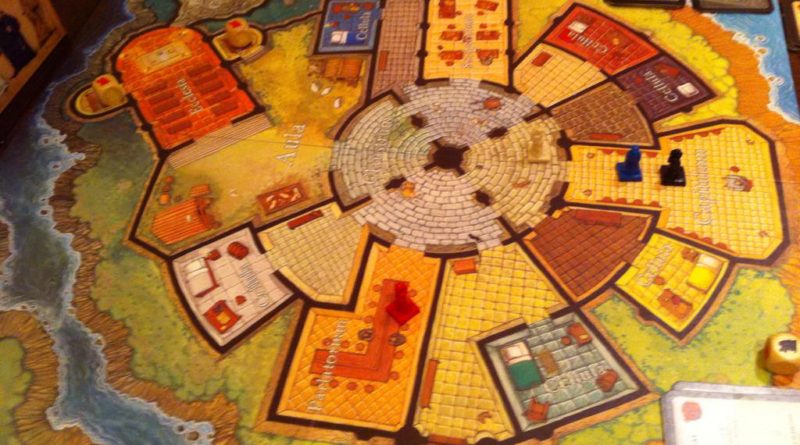Board Game Review: Mystery of the Abbey
This is another one of those unhelpful reviews like The Queen’s Gambit was, because Mystery of the Abbey is out of print and can only be found online for crazy prices (see Amazon and Ebay here). However, I think it makes a strong argument for finding itself in your collection.
 Mystery of the Abbey is designed by Bruno Faidutti and is what happens when you mash together Guess Who, Clue, and The Name of the Rose. Players are monks summoned to the Templars’ Abbey to solve the murder of Brother Adelmo who mysteriously fell from a cliffside.
Mystery of the Abbey is designed by Bruno Faidutti and is what happens when you mash together Guess Who, Clue, and The Name of the Rose. Players are monks summoned to the Templars’ Abbey to solve the murder of Brother Adelmo who mysteriously fell from a cliffside.
Players will move around the board, collecting clues through visiting different parts of the Abbey. Each player has a sheet of potential witnesses. Each witness is unique, with various defining features: bearded or unbearded, fat or thin, bald or hooded, one of three different orders of monks, and one of three ranks. One of these monks’ cards is under the board as the murderer. Many of the cards are in the hands of the players.
 Your goal is to determine which monk threw Adelmo off the cliff. The game is split up between the various masses held throughout the day. Players must move through the Abbey before returning to the chapel every four actions. Players may go into the confessional booth to find out information from the last player to enter the booth (the monk taking confession is very chatty), they can enter another monk’s cell (and try not to get caught doing it), they can take documents from the scriptorium (where monks write books) or the library which grant special actions, and they can visit the parlor, which provides news from the outside world, collecting more cards of the various monks on the accusation sheet, so they can begin checking more monks off the list.
Your goal is to determine which monk threw Adelmo off the cliff. The game is split up between the various masses held throughout the day. Players must move through the Abbey before returning to the chapel every four actions. Players may go into the confessional booth to find out information from the last player to enter the booth (the monk taking confession is very chatty), they can enter another monk’s cell (and try not to get caught doing it), they can take documents from the scriptorium (where monks write books) or the library which grant special actions, and they can visit the parlor, which provides news from the outside world, collecting more cards of the various monks on the accusation sheet, so they can begin checking more monks off the list.
 Monks can also question one another, asking questions like “Have you ruled out all Franciscan monks?” or “Do you still have a fat bald monk as a suspect?” If a monk agrees to answer the question, they may ask their own question and the other monk must answer it. The monk first questioned can choose to take a “vow of silence,” however and refuse to answer, but they don’t get their own question to ask. The monks also pass around the cards of the monks they began with each time they meet in the chapel as the monks exchange information during mass.
Monks can also question one another, asking questions like “Have you ruled out all Franciscan monks?” or “Do you still have a fat bald monk as a suspect?” If a monk agrees to answer the question, they may ask their own question and the other monk must answer it. The monk first questioned can choose to take a “vow of silence,” however and refuse to answer, but they don’t get their own question to ask. The monks also pass around the cards of the monks they began with each time they meet in the chapel as the monks exchange information during mass.
Monks are able to go to the chapter hall to make a Revelation or an Accusation. Revelations are when you have definitive proof (or are very sure) of something. You can say, “The culprit is a Franciscan,” or “the culprit is a Novice.” Your revelations are a single statement with a single fact and cannot be a negative statement like “the culprit is NOT a Novice.” You then write down this revelation on your sheet. If, at the end of the game you are correct, you get 2 points. If your revelation is wrong, you get -1 points.
Accusations are when a player wants to state who the murderer is. They cannot do so while there are still cards in the parlor. If they make an accusation that another player has a card for, it can’t be true, and so must pay penance by losing a turn and going to the chapel. A false accusation is -2 points, while the correct accusation is 4 points. This means that you can conceivably guess the culprit correctly and still lose due to another player correctly making revelations throughout the game.
I absolutely love Mystery of the Abbey. The artwork on the board and all the cards is gorgeous, the gameplay is simple enough to teach in only a few minutes, and is different every time. Will you spend your time questioning other monks? Will you scour the library for clues? Are you going to break into your fellow monks’ cells for information? What about those pesky friars taking confession? Perhaps you should visit the Crypt to gain extra actions (oh, by the way, you can do that too).
This game is one you should pick up as soon as possible. I’m really disappointed that Days of Wonder hasn’t reprinted the game, but I hope they do soon.




